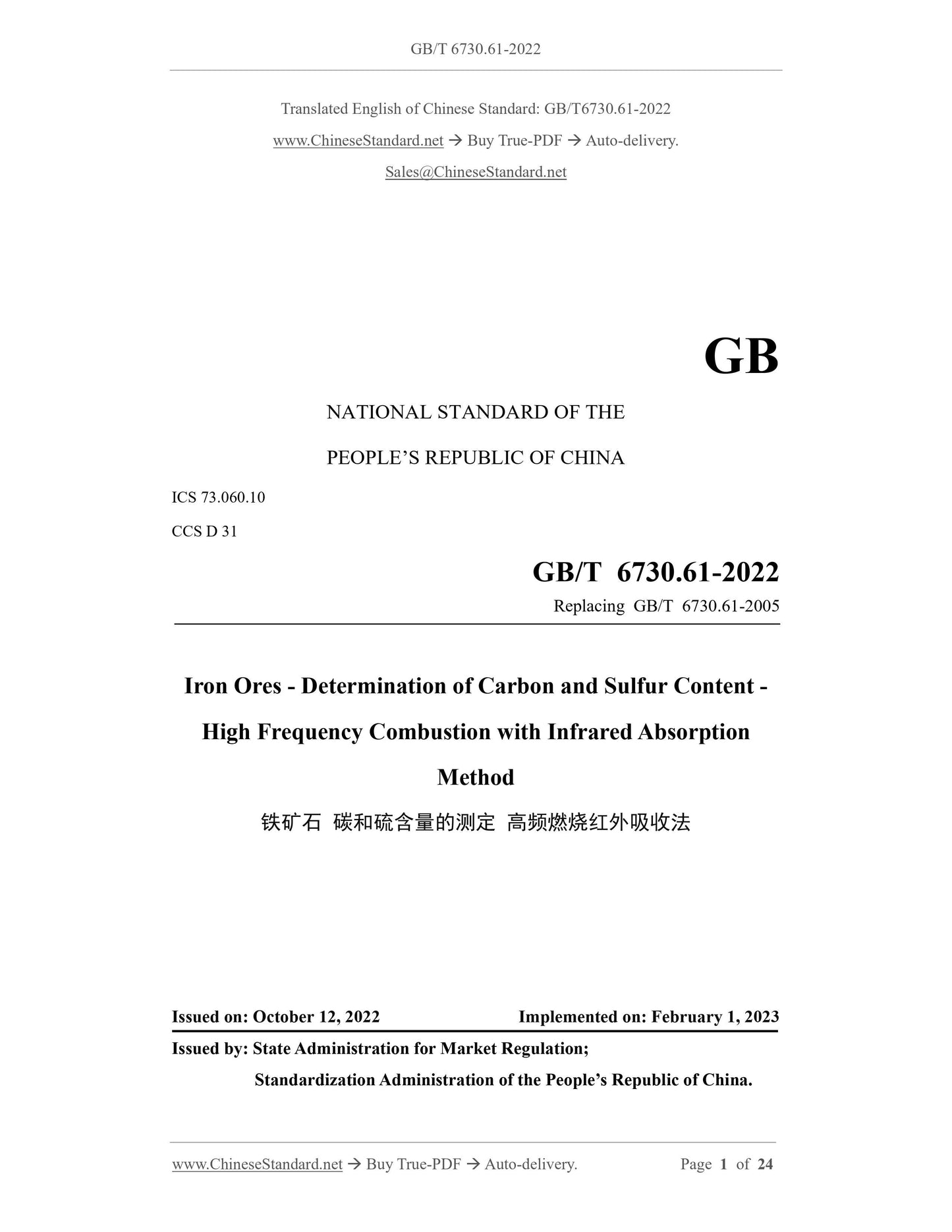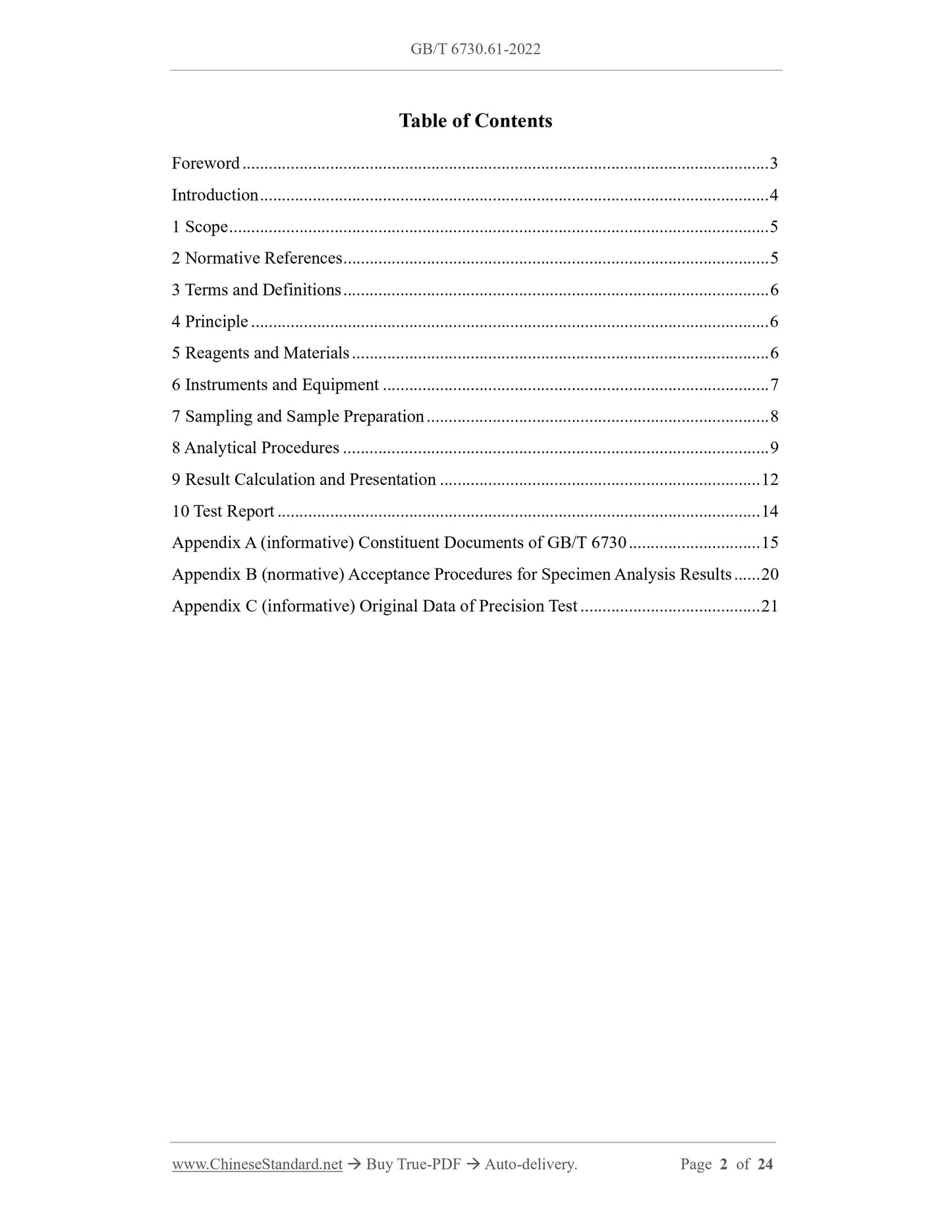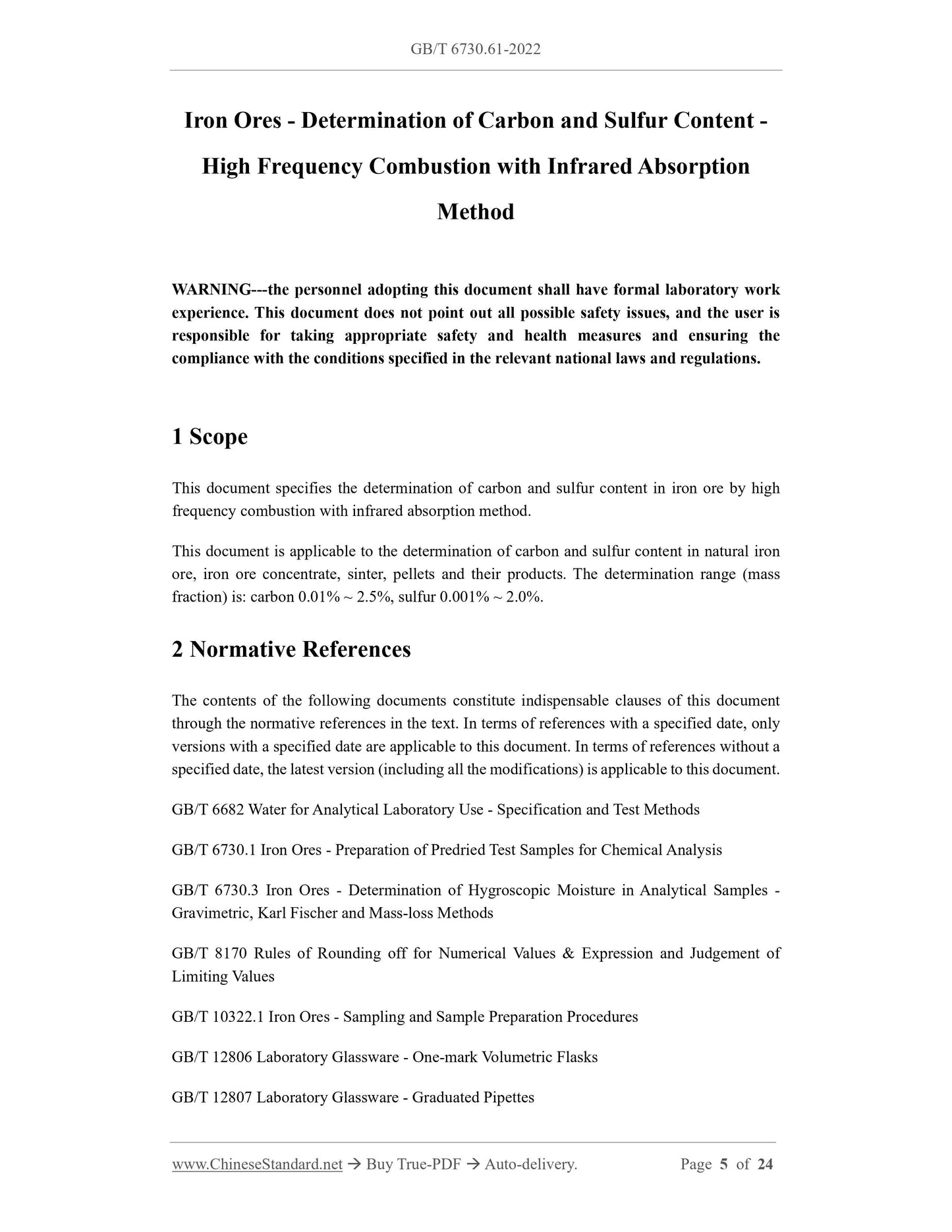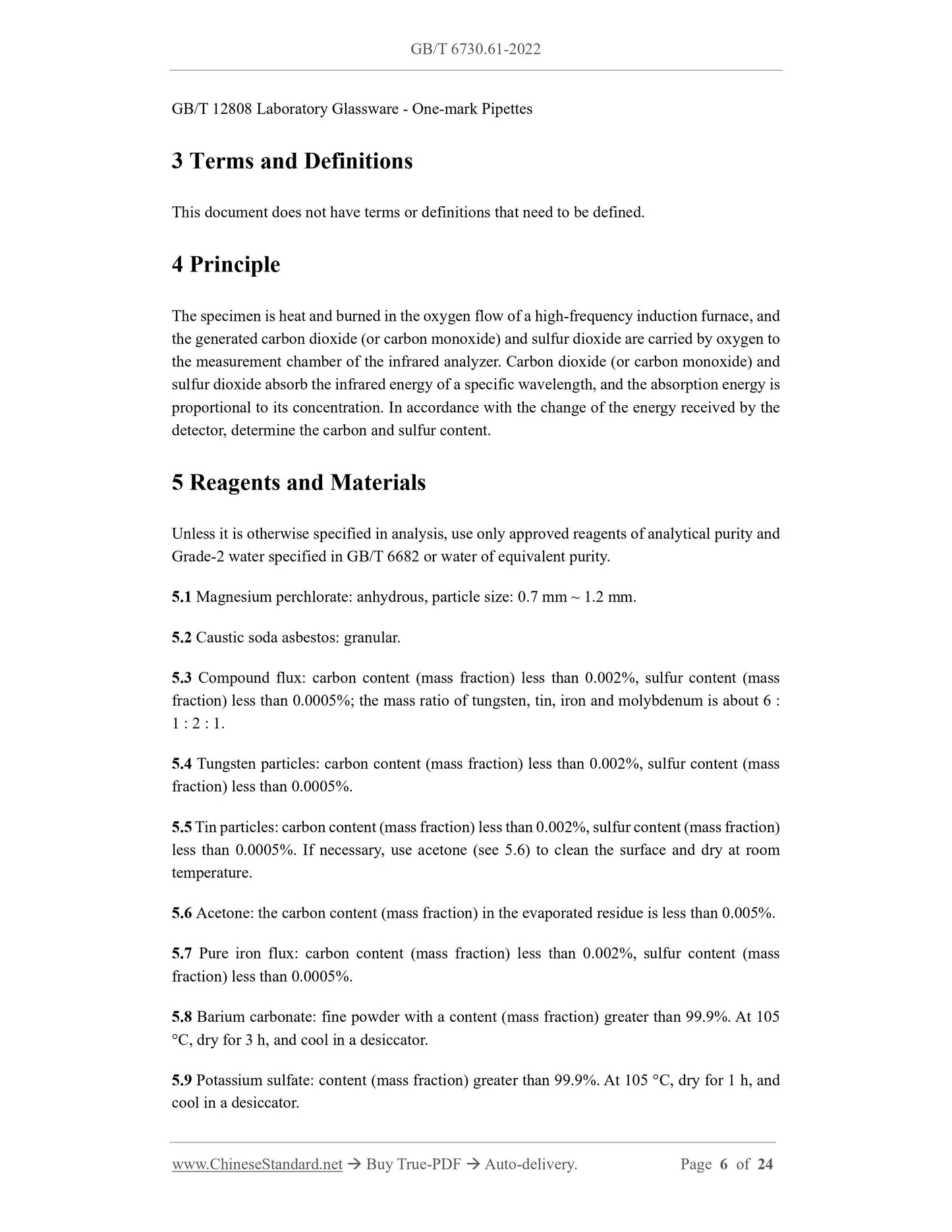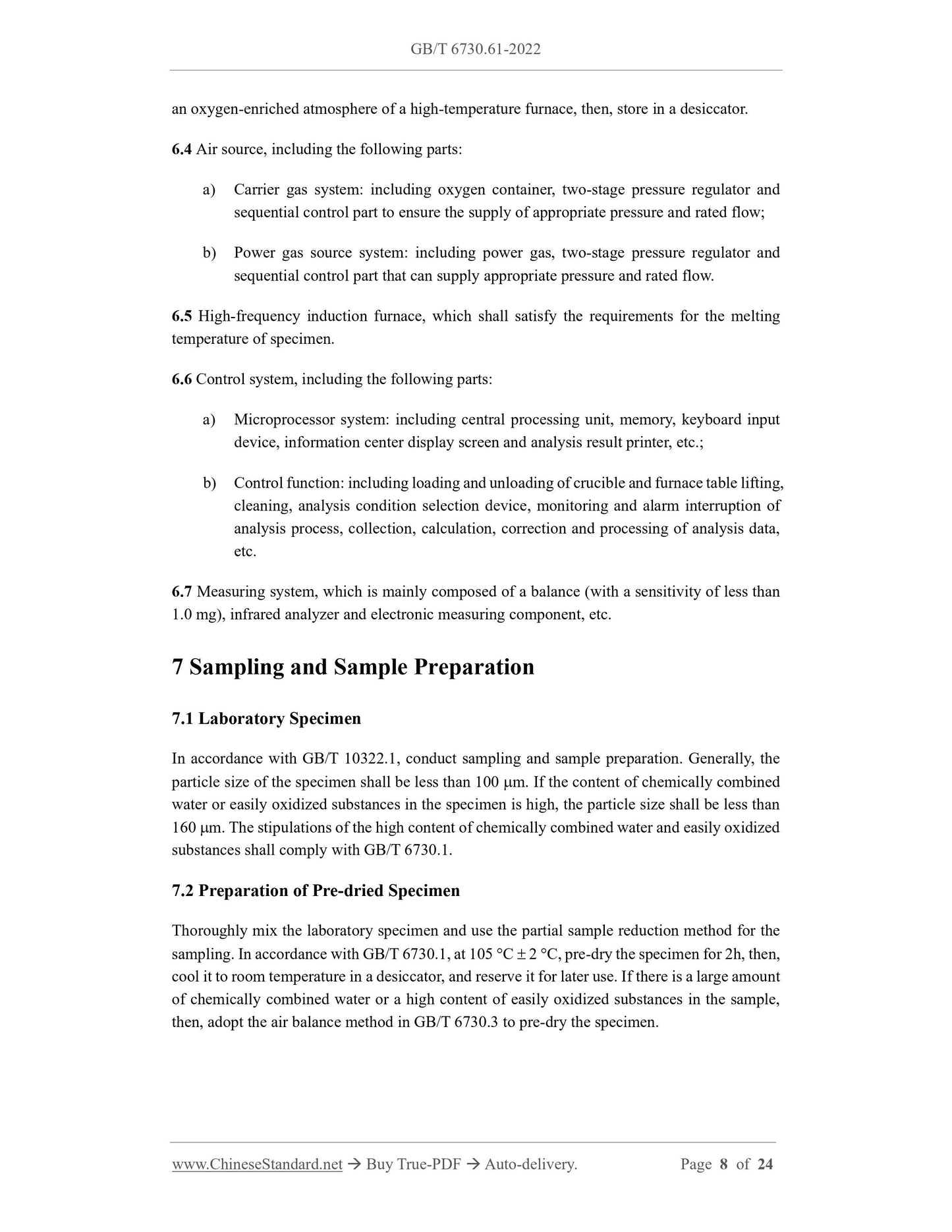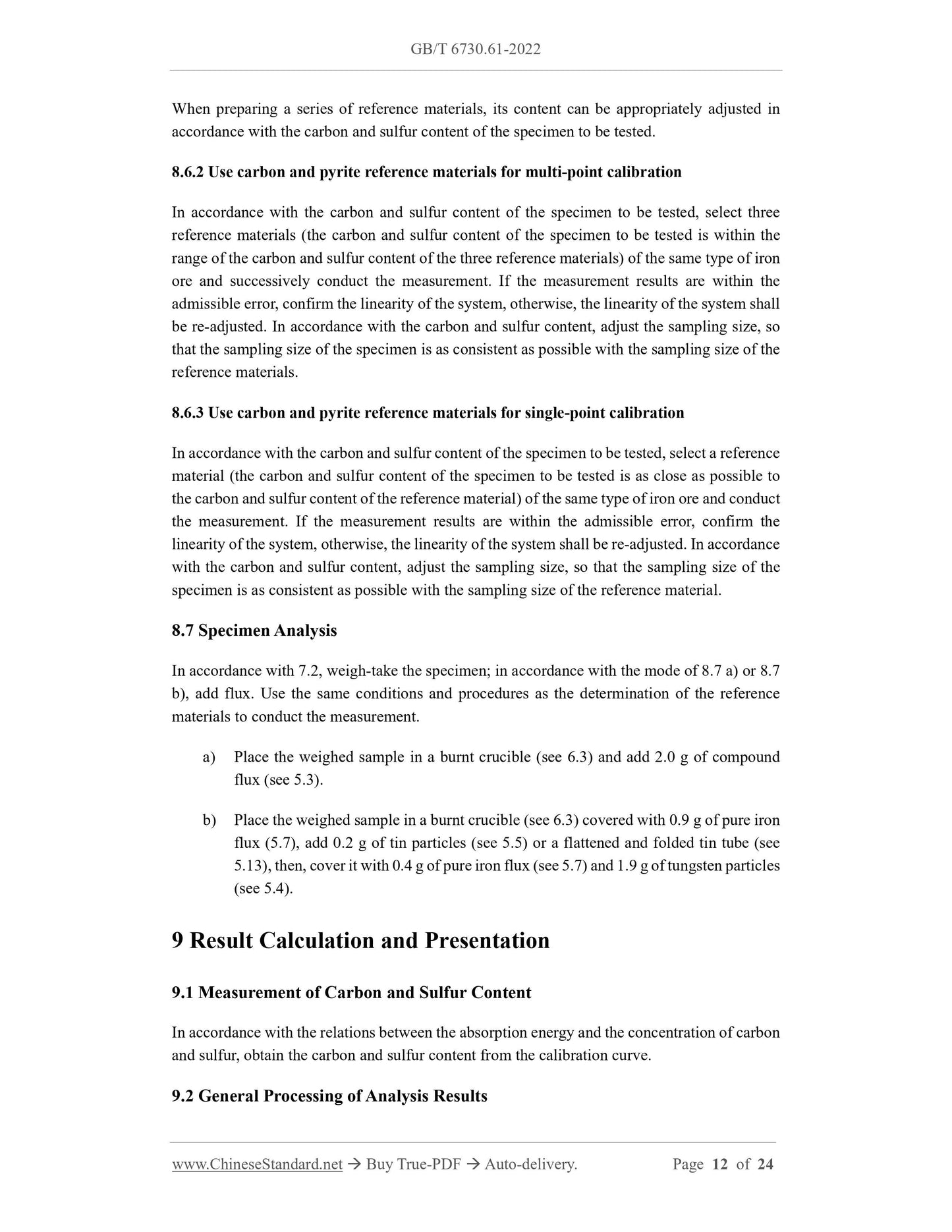PayPal, credit cards. Download editable-PDF & invoice in 1 second!
GB/T 6730.61-2022 English PDF (GBT6730.61-2022)
GB/T 6730.61-2022 English PDF (GBT6730.61-2022)
Precio habitual
$260.00 USD
Precio habitual
Precio de oferta
$260.00 USD
Precio unitario
/
por
Los gastos de envío se calculan en la pantalla de pago.
No se pudo cargar la disponibilidad de retiro
Delivery: 3 seconds. Download true-PDF + Invoice.
Get QUOTATION in 1-minute: Click GB/T 6730.61-2022
Historical versions: GB/T 6730.61-2022
Preview True-PDF (Reload/Scroll if blank)
GB/T 6730.61-2022: Iron ores -- Determination of carbon and sulfur content -- High frequency combustion with infrared absorption method
GB/T 6730.61-2022
GB
NATIONAL STANDARD OF THE
PEOPLE’S REPUBLIC OF CHINA
ICS 73.060.10
CCS D 31
Replacing GB/T 6730.61-2005
Iron Ores - Determination of Carbon and Sulfur Content -
High Frequency Combustion with Infrared Absorption
Method
ISSUED ON: OCTOBER 12, 2022
IMPLEMENTED ON: FEBRUARY 1, 2023
Issued by: State Administration for Market Regulation;
Standardization Administration of the People’s Republic of China.
Table of Contents
Foreword ... 3
Introduction ... 4
1 Scope ... 5
2 Normative References ... 5
3 Terms and Definitions ... 6
4 Principle ... 6
5 Reagents and Materials ... 6
6 Instruments and Equipment ... 7
7 Sampling and Sample Preparation ... 8
8 Analytical Procedures ... 9
9 Result Calculation and Presentation ... 12
10 Test Report ... 14
Appendix A (informative) Constituent Documents of GB/T 6730 ... 15
Appendix B (normative) Acceptance Procedures for Specimen Analysis Results ... 20
Appendix C (informative) Original Data of Precision Test ... 21
Iron Ores - Determination of Carbon and Sulfur Content -
High Frequency Combustion with Infrared Absorption
Method
WARNING---the personnel adopting this document shall have formal laboratory work
experience. This document does not point out all possible safety issues, and the user is
responsible for taking appropriate safety and health measures and ensuring the
compliance with the conditions specified in the relevant national laws and regulations.
1 Scope
This document specifies the determination of carbon and sulfur content in iron ore by high
frequency combustion with infrared absorption method.
This document is applicable to the determination of carbon and sulfur content in natural iron
ore, iron ore concentrate, sinter, pellets and their products. The determination range (mass
fraction) is: carbon 0.01% ~ 2.5%, sulfur 0.001% ~ 2.0%.
2 Normative References
The contents of the following documents constitute indispensable clauses of this document
through the normative references in the text. In terms of references with a specified date, only
versions with a specified date are applicable to this document. In terms of references without a
specified date, the latest version (including all the modifications) is applicable to this document.
GB/T 6682 Water for Analytical Laboratory Use - Specification and Test Methods
GB/T 6730.1 Iron Ores - Preparation of Predried Test Samples for Chemical Analysis
GB/T 6730.3 Iron Ores - Determination of Hygroscopic Moisture in Analytical Samples -
Gravimetric, Karl Fischer and Mass-loss Methods
GB/T 8170 Rules of Rounding off for Numerical Values and Expression and Judgement of
Limiting Values
GB/T 10322.1 Iron Ores - Sampling and Sample Preparation Procedures
GB/T 12806 Laboratory Glassware - One-mark Volumetric Flasks
GB/T 12807 Laboratory Glassware - Graduated Pipettes
GB/T 12808 Laboratory Glassware - One-mark Pipettes
3 Terms and Definitions
This document does not have terms or definitions that need to be defined.
4 Principle
The specimen is heat and burned in the oxygen flow of a high-frequency induction furnace, and
the generated carbon dioxide (or carbon monoxide) and sulfur dioxide are carried by oxygen to
the measurement chamber of the infrared analyzer. Carbon dioxide (or carbon monoxide) and
sulfur dioxide absorb the infrared energy of a specific wavelength, and the absorption energy is
proportional to its concentration. In accordance with the change of the energy received by the
detector, determine the carbon and sulfur content.
5 Reagents and Materials
Unless it is otherwise specified in analysis, use only approved reagents of analytical purity and
Grade-2 water specified in GB/T 6682 or water of equivalent purity.
5.1 Magnesium perchlorate: anhydrous, particle size: 0.7 mm ~ 1.2 mm.
5.2 Caustic soda asbestos: granular.
5.3 Compound flux: carbon content (mass fraction) less than 0.002%, sulfur content (mass
fraction) less than 0.0005%; the mass ratio of tungsten, tin, iron and molybdenum is about 6 :
1 : 2 : 1.
5.4 Tungsten particles: carbon content (mass fraction) less than 0.002%, sulfur content (mass
fraction) less than 0.0005%.
5.5 Tin particles: carbon content (mass fraction) less than 0.002%, sulfur content (mass fraction)
less than 0.0005%. If necessary, use acetone (see 5.6) to clean the surface and dry at room
temperature.
5.6 Acetone: the carbon content (mass fraction) in the evaporated residue is less than 0.005%.
5.7 Pure iron flux: carbon content (mass fraction) less than 0.002%, sulfur content (mass
fraction) less than 0.0005%.
5.8 Barium carbonate: fine powder with a content (mass fraction) greater than 99.9%. At 105
C, dry for 3 h, and cool in a desiccator.
5.9 Potassium sulfate: content (mass fraction) greater than 99.9%. At 105 C, dry for 1 h, and
cool in a desiccator.
an oxygen-enriched atmosphere of a high-temperature furnace, then, store in a desiccator.
6.4 Air source, including the following parts:
a) Carrier gas system: including oxygen container, two-stage pressure regulator and
sequential control part to ensure the supply of appropriate pressure and rated flow;
b) Power gas source system: including power gas, two-stage pressure regulator and
sequential control part that can supply appropriate pressure and rated flow.
6.5 High-frequency induction furnace, which shall satisfy the requirements for the melting
temperature of specimen.
6.6 Control system, including the following parts:
a) Microprocessor system: including central processing unit, memory, keyboard input
device, information center display screen and analysis result printer, etc.;
b) Control function: including loading and unloading of crucible and furnace table lifting,
cleaning, analysis condition selection device, monitoring and alarm interruption of
analysis process, collection, calculation, correction and processing of analysis data,
etc.
6.7 Measuring system, which is mainly composed of a balance (with a sensitivity of less than
1.0 mg), infrared analyzer and electronic measuring component, etc.
7 Sampling and Sample Preparation
7.1 Laboratory Specimen
In accordance with GB/T 10322.1, conduct sampling and sample preparation. Generally, the
particle size of the specimen shall be less than 100 m. If the content of chemically combined
water or easily oxidized substances in the specimen is high, the particle size shall be less than
160 m. The stipulations of the high content of chemically combined water and easily oxidized
substances shall comply with GB/T 6730.1.
7.2 Preparation of Pre-dried Specimen
Thoroughly mix the laboratory specimen and use the partial sample reduction method for the
sampling. In accordance with GB/T 6730.1, at 105 C 2 C, pre-dry the specimen for 2h, then,
cool it to room temperature in a desiccator, and reserve it for later use. If there is a large amount
of chemically combined water or a high content of easily oxidized substances in the sample,
then, adopt the air balance method in GB/T 6730.3 to pre-dry the specimen.
When preparing a series of reference materials, its content can be appropriately adjusted in
accordance with the carbon and sulfur content of the specimen to be tested.
8.6.2 Use carbon and pyrite reference materials for multi-point calibration
In accordance with the carbon and sulfur content of the specimen to be tested, select three
reference materials (the carbon and sulfur content of the specimen to be tested is wi...
Get QUOTATION in 1-minute: Click GB/T 6730.61-2022
Historical versions: GB/T 6730.61-2022
Preview True-PDF (Reload/Scroll if blank)
GB/T 6730.61-2022: Iron ores -- Determination of carbon and sulfur content -- High frequency combustion with infrared absorption method
GB/T 6730.61-2022
GB
NATIONAL STANDARD OF THE
PEOPLE’S REPUBLIC OF CHINA
ICS 73.060.10
CCS D 31
Replacing GB/T 6730.61-2005
Iron Ores - Determination of Carbon and Sulfur Content -
High Frequency Combustion with Infrared Absorption
Method
ISSUED ON: OCTOBER 12, 2022
IMPLEMENTED ON: FEBRUARY 1, 2023
Issued by: State Administration for Market Regulation;
Standardization Administration of the People’s Republic of China.
Table of Contents
Foreword ... 3
Introduction ... 4
1 Scope ... 5
2 Normative References ... 5
3 Terms and Definitions ... 6
4 Principle ... 6
5 Reagents and Materials ... 6
6 Instruments and Equipment ... 7
7 Sampling and Sample Preparation ... 8
8 Analytical Procedures ... 9
9 Result Calculation and Presentation ... 12
10 Test Report ... 14
Appendix A (informative) Constituent Documents of GB/T 6730 ... 15
Appendix B (normative) Acceptance Procedures for Specimen Analysis Results ... 20
Appendix C (informative) Original Data of Precision Test ... 21
Iron Ores - Determination of Carbon and Sulfur Content -
High Frequency Combustion with Infrared Absorption
Method
WARNING---the personnel adopting this document shall have formal laboratory work
experience. This document does not point out all possible safety issues, and the user is
responsible for taking appropriate safety and health measures and ensuring the
compliance with the conditions specified in the relevant national laws and regulations.
1 Scope
This document specifies the determination of carbon and sulfur content in iron ore by high
frequency combustion with infrared absorption method.
This document is applicable to the determination of carbon and sulfur content in natural iron
ore, iron ore concentrate, sinter, pellets and their products. The determination range (mass
fraction) is: carbon 0.01% ~ 2.5%, sulfur 0.001% ~ 2.0%.
2 Normative References
The contents of the following documents constitute indispensable clauses of this document
through the normative references in the text. In terms of references with a specified date, only
versions with a specified date are applicable to this document. In terms of references without a
specified date, the latest version (including all the modifications) is applicable to this document.
GB/T 6682 Water for Analytical Laboratory Use - Specification and Test Methods
GB/T 6730.1 Iron Ores - Preparation of Predried Test Samples for Chemical Analysis
GB/T 6730.3 Iron Ores - Determination of Hygroscopic Moisture in Analytical Samples -
Gravimetric, Karl Fischer and Mass-loss Methods
GB/T 8170 Rules of Rounding off for Numerical Values and Expression and Judgement of
Limiting Values
GB/T 10322.1 Iron Ores - Sampling and Sample Preparation Procedures
GB/T 12806 Laboratory Glassware - One-mark Volumetric Flasks
GB/T 12807 Laboratory Glassware - Graduated Pipettes
GB/T 12808 Laboratory Glassware - One-mark Pipettes
3 Terms and Definitions
This document does not have terms or definitions that need to be defined.
4 Principle
The specimen is heat and burned in the oxygen flow of a high-frequency induction furnace, and
the generated carbon dioxide (or carbon monoxide) and sulfur dioxide are carried by oxygen to
the measurement chamber of the infrared analyzer. Carbon dioxide (or carbon monoxide) and
sulfur dioxide absorb the infrared energy of a specific wavelength, and the absorption energy is
proportional to its concentration. In accordance with the change of the energy received by the
detector, determine the carbon and sulfur content.
5 Reagents and Materials
Unless it is otherwise specified in analysis, use only approved reagents of analytical purity and
Grade-2 water specified in GB/T 6682 or water of equivalent purity.
5.1 Magnesium perchlorate: anhydrous, particle size: 0.7 mm ~ 1.2 mm.
5.2 Caustic soda asbestos: granular.
5.3 Compound flux: carbon content (mass fraction) less than 0.002%, sulfur content (mass
fraction) less than 0.0005%; the mass ratio of tungsten, tin, iron and molybdenum is about 6 :
1 : 2 : 1.
5.4 Tungsten particles: carbon content (mass fraction) less than 0.002%, sulfur content (mass
fraction) less than 0.0005%.
5.5 Tin particles: carbon content (mass fraction) less than 0.002%, sulfur content (mass fraction)
less than 0.0005%. If necessary, use acetone (see 5.6) to clean the surface and dry at room
temperature.
5.6 Acetone: the carbon content (mass fraction) in the evaporated residue is less than 0.005%.
5.7 Pure iron flux: carbon content (mass fraction) less than 0.002%, sulfur content (mass
fraction) less than 0.0005%.
5.8 Barium carbonate: fine powder with a content (mass fraction) greater than 99.9%. At 105
C, dry for 3 h, and cool in a desiccator.
5.9 Potassium sulfate: content (mass fraction) greater than 99.9%. At 105 C, dry for 1 h, and
cool in a desiccator.
an oxygen-enriched atmosphere of a high-temperature furnace, then, store in a desiccator.
6.4 Air source, including the following parts:
a) Carrier gas system: including oxygen container, two-stage pressure regulator and
sequential control part to ensure the supply of appropriate pressure and rated flow;
b) Power gas source system: including power gas, two-stage pressure regulator and
sequential control part that can supply appropriate pressure and rated flow.
6.5 High-frequency induction furnace, which shall satisfy the requirements for the melting
temperature of specimen.
6.6 Control system, including the following parts:
a) Microprocessor system: including central processing unit, memory, keyboard input
device, information center display screen and analysis result printer, etc.;
b) Control function: including loading and unloading of crucible and furnace table lifting,
cleaning, analysis condition selection device, monitoring and alarm interruption of
analysis process, collection, calculation, correction and processing of analysis data,
etc.
6.7 Measuring system, which is mainly composed of a balance (with a sensitivity of less than
1.0 mg), infrared analyzer and electronic measuring component, etc.
7 Sampling and Sample Preparation
7.1 Laboratory Specimen
In accordance with GB/T 10322.1, conduct sampling and sample preparation. Generally, the
particle size of the specimen shall be less than 100 m. If the content of chemically combined
water or easily oxidized substances in the specimen is high, the particle size shall be less than
160 m. The stipulations of the high content of chemically combined water and easily oxidized
substances shall comply with GB/T 6730.1.
7.2 Preparation of Pre-dried Specimen
Thoroughly mix the laboratory specimen and use the partial sample reduction method for the
sampling. In accordance with GB/T 6730.1, at 105 C 2 C, pre-dry the specimen for 2h, then,
cool it to room temperature in a desiccator, and reserve it for later use. If there is a large amount
of chemically combined water or a high content of easily oxidized substances in the sample,
then, adopt the air balance method in GB/T 6730.3 to pre-dry the specimen.
When preparing a series of reference materials, its content can be appropriately adjusted in
accordance with the carbon and sulfur content of the specimen to be tested.
8.6.2 Use carbon and pyrite reference materials for multi-point calibration
In accordance with the carbon and sulfur content of the specimen to be tested, select three
reference materials (the carbon and sulfur content of the specimen to be tested is wi...
Share
